Well, when we booked our hotel break, we had used Booking.com. Having narrowly avoided reserving a hotel in Gijón, we managed to secure a good deal in Oviedo. It transpired that the option to book B&B AND parking only worked for a single traveller. We were fully expecting an extra bill at checkout. Which we didn’t get. We really like the girls on reception!
Time to leave before anyone changes their minds and sets up a road block to extract more euros! To add to our chances of escape, we decide to avoid the coastal motorway (predictable, fast and easy, but detached from local colour and excitement). We took the inland road along the foothills of the Picos Mountains (slow, winding and far too full of excitement)!
Navigation in this part of Spain is complicated by the Asturians insistence on signposting towns by names in two languages. Sometimes with one.version, sometimes with the other, occasionally with both. Our map usually had “the other”, so we were often surprised to be somewhere we weren’t expecting to be! It’s all to do with “toponomy”! We were only just coming to terms with Gijón pronounced “Heehonn”, now it can be Xixón. Maybe that sounds the same.
The road started out quite “main” and we detoured slightly into Nava for a coffee and a walk along the stream that runs through the village. It’s a tiny place but has two “Sidrias” where you can drink flat cider, frothed by vigorous pouring. The village is also home to the museum of Asturian Cider. We stuck with coffee!
The next stop was at what we will call Arriondas. Situated on the Sella River some 65 km East of Oviedo, now famous for kayaking down the river and, apparently, salmon fishing. In August the town hosts the “International Descent of the Sella” known as Las Piraguas. A 20 km kayak race from Arriondas to Ribadesella.
The town also has some isolated bits of lovely architecture with an Indian influence.
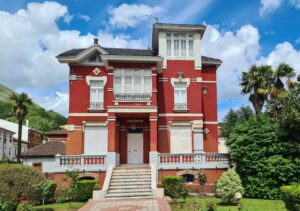 .
.
We saw three of these, two had been restored one was ready for workmen to move in. There is also a rather odd fountain in the Place Venancio Pando – the Fuente del Cañion.
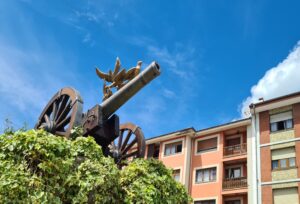
Really not sure what that was about! Anyway, as we left town we diverted onto a smaller road heading into the Picos. At Cangas de Onis we found a rather splendid Roman Bridge, the “Puente Vieyu”:
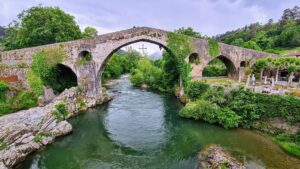
However, although this site may have been used in Roman times to cross the Sella River, in fact the current “Roman Bridge” only dates back to mediaeval times, possibly to the end of the 13th century.
I suppose the height of the arch is a reflection of the physics of its construction, rather than concern for the once in 5,000 year flood levels.
Leaving Cangas, we downgraded yet again to a small winding road which passed the villages of Con, Poo (really) and Las Arenas following a river through what appeared to be Cheddar Gorge on steroids.
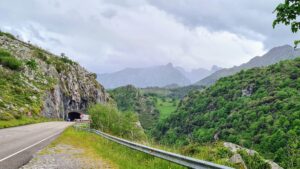
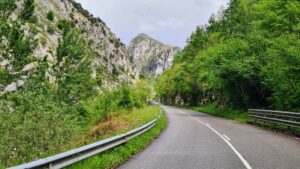
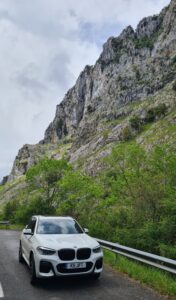
All the way to Mildón. Where the road stopped. It just stopped! No warning. No suggestions. No diversions. No happy campers!
Fortunately, also stuck at the road block (which had obviously been there for months), were a German motorcyclist, a French campervan and a Dutch hiker. The German knew about a route over the mountains but wasn’t sure how to find it, the Frenchman had a map and we are good at following. (We left the Dutchman sitting by the road, crying!) So about turn and back up the ravine to Las Arenas where an unlikely looking tiny side road took us on a hundred km diversion through mountain villages to get us round the closed section (marked red).
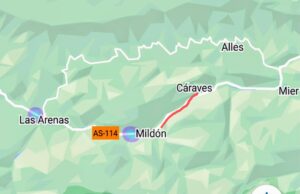
Stick with us if you want any sort of navigational experience! We were certainly ready for tea when we got “home”!
After a few days, it was time to move on. Glenda has the super idea of driving to France over the Pyrenees! I compromise by agreeing to move TOWARDS said mountain range. There are three campsites just to the West of Pamplona. We choose one and messaged them. “Yes, please come to our beautiful site!” Excellent! Off we go.
There were a few navigation related discussions as we circled Bilbao and headed south on the N roads, cunningly avoiding the toll road which would have got us to our destination two days earlier. But at least we got familiar with a fair few Spanish trucks including one massive low-loader which had got itself jammed on a roundabout for everyone’s convenience! On the up-side, my road of choice did pass a few eateries. We parked at one of these (Restaurant Arratiano at Jatetxea) in the middle of their huge carpark where we could watch for hijackers and other disreputable characters. (Two years on from our “incident” with robbers, and we are still a little nervous!)
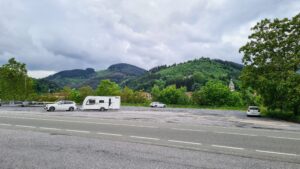
The meal was excellent, basic but excellent! The serving wenches, on the other hand, were a little … a little … er … disconcerting!
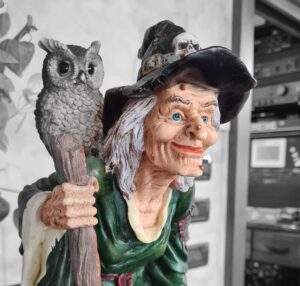
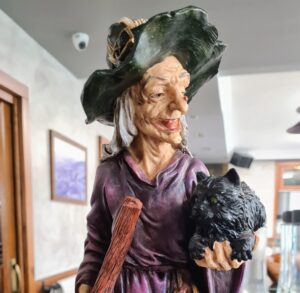
I don’t think many people leave without paying!
The “beautiful site” to which we are heading turned out to be waterlogged and deserted! So having gone through the tedious check-in process, we immediately went through the check-out process! Apparently, the next nearest site was similarly affected. So it was number three. Urbasa. OK, so it is on top of a mountain, but it should be fine provided we don’t take the route as signed from the main road. We subsequently discovered that the forbidden (but sign-posted) route was single lane for the first two km!
A track of the last 8 km of our approach is shown here! As we approached it didn’t seem possible that a road could go up a thousand metres so vertically – let alone a caravan!
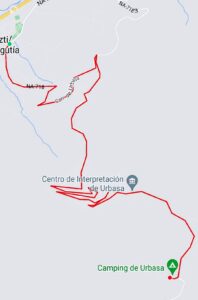
At the top, the terrain opened up as a gently undulating plateau. A complete surprise. The camp site was huge and, predictably, virtually empty. The guardian met us with a two minute explanation – free parking anywhere you like, electricity, showers, toilets, bar and restaurant are there, there and there – and I’m off to Pamplona to visit my girl friend!. See you in the morning to sort the paperwork! We selected a patch of dry ground and got established.

Our view out the front was superb:
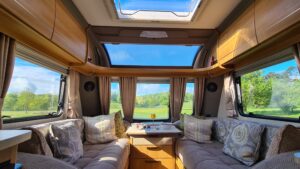
Within a couple km from the site, there are some beautiful walks in the “massive forest” which makes up a fair percentage of the Urbasa National Park. This is called the “Hayedo Encantado” or the “Enchanted Beech Wood”. An excellent name for this beautiful area with its moss-encrusted boulders, massive beech trees and numerous sink holes!
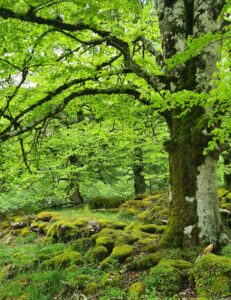
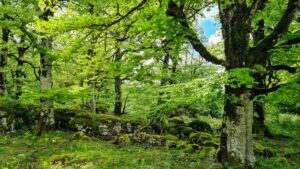
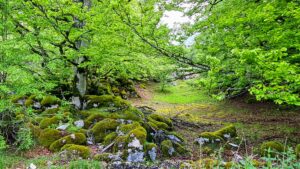
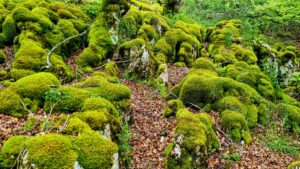
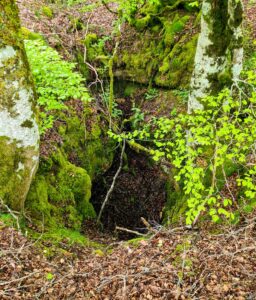
In the more open areas, there were a lot of lovely Spring flowers:
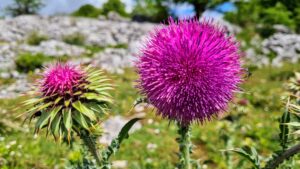
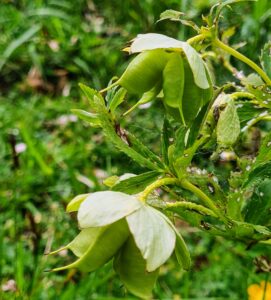

While overhead, vultures circled menacingly!
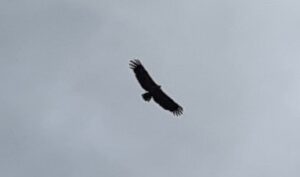
A beautiful walk!
The next day we walked in the more open ground around and to the West of the campsite. Worrying signs at the outset indicated destinations 30+ and 40+ km away. I was hoping for something a little less enthusiastic. Say three km out and three back. In the end, we settled for a three mile “destination-less” amble among micro-herds of cows, horses and donkeys.
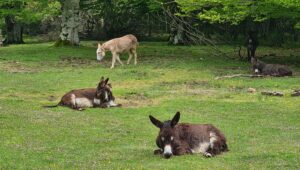
Later we drove off the back (North) side of our mountain to the village of Estella. Still steep, but nowhere near as alarmingly vertical as the South face!

it was lunchtime as we descended through Zudaire. The great thing about meal times in Spain is that they are all “time-shifted”. Their midday meal rarely starts before 1 pm and can often be taken as late as 3 or 4 pm. I guess it’s all to do with siestas and dinner eaten after 9 or 10 pm. Suits us brilliantly! So Restaurant Ibaisek it was!
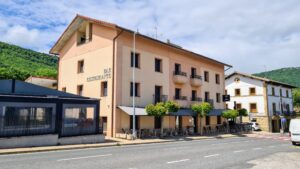
Followed by an energetic walk round town (all roads here go up or down!) (Maybe that should be “up AND down”!)

The Iglesia de San Andrés.
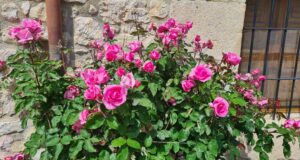
The “village” of Estella (or Lizarra as it is also known as) turned out to be a substantial town. But it was getting late, so we filled with fuel and shot off up the “main” road towards Pamplona. “Up”, of course being the operative word!
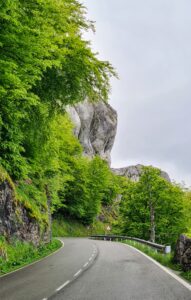
The vague plan was to try to find the tiny track which runs through the Enchanted Wood and would join our current road with that running past the campsite. This would save us going down the mountain, round the bottom and back up again. We found the track, but it looked far too tricky for us to even attempt! So … lots more hairpins!
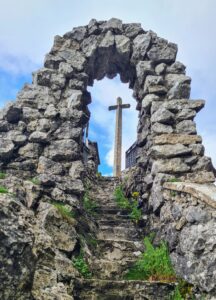
A quick prayer at this roadside shrine, then down, down, down!
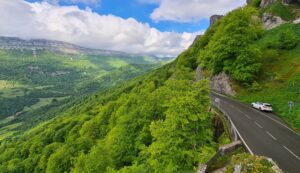
Then up, up, up!

The next morning two trucks appeared beside us and offloaded heaps of stuff. This, it turned out, was a collection of about a dozen tents in kit form. Gradually a small forest of canvas accommodation circled our pitch. We just got out before being enclosed for the season! They did give us a 50% reduction on the camp fees, but we were out of there!
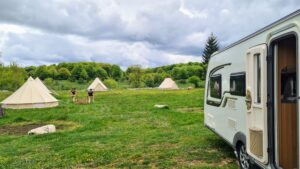
So, down the face of the Eiger again and North towards the French border. This, of course meant another significant climb before descending into Sunbilla about 25 km short of the border for our last stop in Spain. It also gave Glenda several opportunities to over-ride the car’s instinct to take us on remote mountain roads.
The village is tucked tightly into a piece of more or less horizontal land between the main road and the mountains to the West. On both banks of the River Bidasoa.
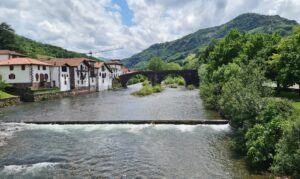
Just room for a church, a town hall (both compulsory), a school a few bar/restaurants (only one open) and a collection of houses and apartments. Very few people. But some very expensive bananas from a travelling fruit vendor.
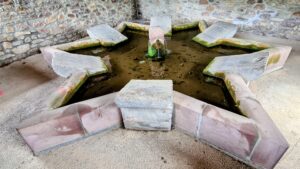
Sunbilla also boasted an old communal washing station – the fore-runner of the launderette. Many villages still have these preserved.
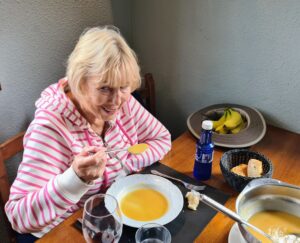
After lunch in the only open restaurant, we drove some eight km up a mountain road to Arantza.
Good views when we got there, but miles of tiddley, twisting mountain road to navigate. At one point a partial loss of road down the steep slope was being repaired. Ten minutes, road open, ten minutes, road closed. The biggest single building in Arantza was the local school. It would be chaos at school closing time.
We left just as the school WAS kicking out! It WAS chaos. Virtually every child at the school lived NOT in the village! The school run every day must be a nightmare! It was bad enough once! There was a bit of a hold up at the bottom of the road where it joined the main road at a roundabout. A little blue car was wedged firmly into the side of one of the road repairers’ trucks! They weren’t going anywhere soon. To get round them we had to negotiate the roundabout the wrong way – scary, but much quicker than waiting for the police to close the road completely! There were a lot of mums with kids stacked up behind the accident when we scarpered!
We spent an interesting evening in our caravan with Stephanie and Simon from Wadebridge. Lots of discussion about their custom converted motor home. One of the few small vans we have seen with decent windows. Glenda tried to half-hitch Steph’s knitted stole. But the stole remained unstolen!
So that’s mountains done. Now for Francia!
The headline in the national newspapers next day was “Mayhem and chaos at the French border – British couple cause massive delays!”
Read all about it (in the next episode)!
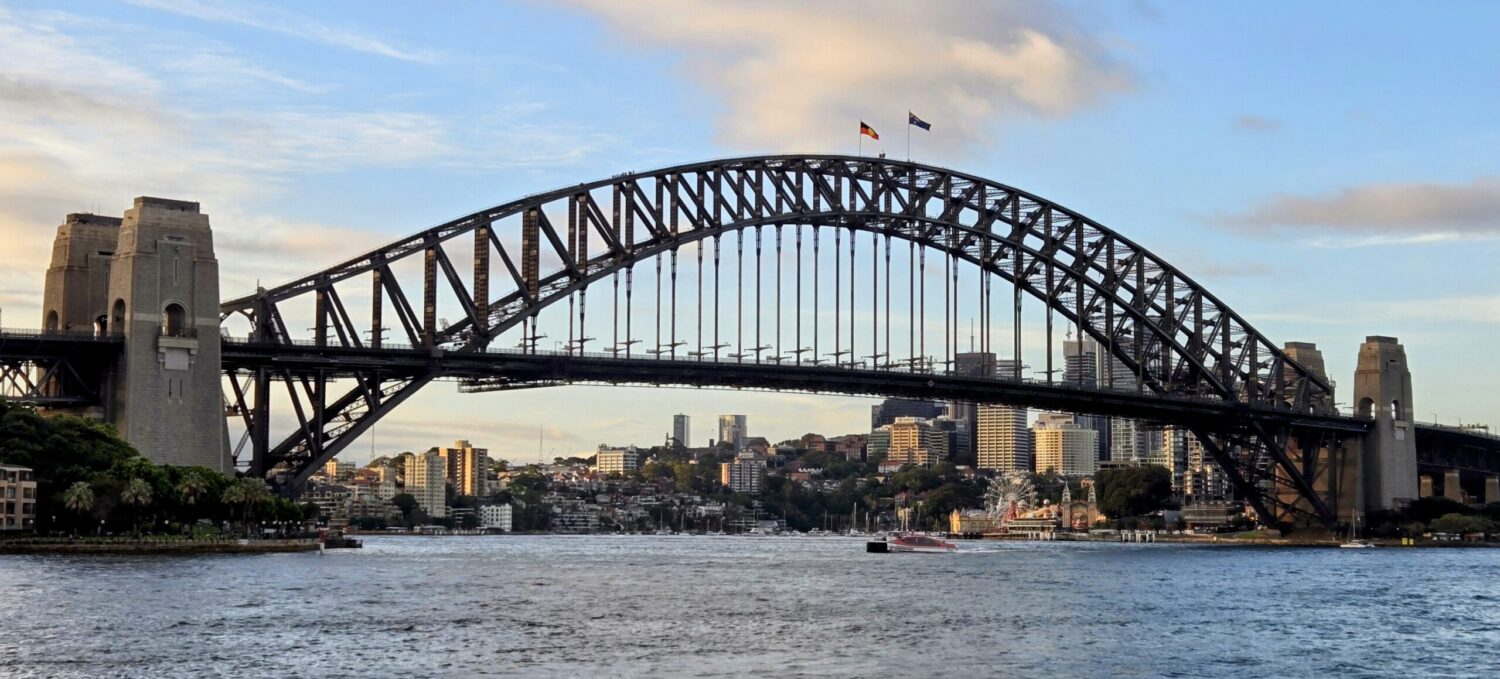
You are very brave and adventurous on the mountain roads! But the photos and tales are worth the trials undergone.
Safe (er) travels
Love this entry (Not that there is anything wrong with the others) – the Roman Bridge, the detour, the beech wood – everything. Could not imagine taking a caravan anywhere near these places.